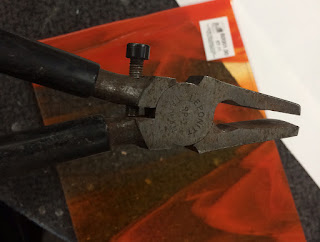The annealing of glass with unknown characteristics is possible in two ways - shotgun and calculated. The examples here are for 6mm thick glass. The soak and cooling times need to be extended for thicker glass.
Both the shotgun and calculated approaches exemplified here assume glass of 6mm thickness. For thicker glass the soak time needs to be extended and the anneal cool rate slowed more than indicated above. Using the Bullseye chart for annealing thick slabs will give you an indication of the relationship of thickness to speed.
1) One is the traditional shotgun
approach – pick an arbitrary, but slightly high temperature, and soak for a minimal amount of time there. Then go very slowly through the next 55°C.
This may be as slow as 25°C per hour, followed by a doubling of that rate
for the next 55°C. Then double again to 300°C or less.
2) By using the slump point test and the calculations, you will be sure
of the annealing point/temperature equalisation point within 10°C. The approach here would be to soak for half an
hour at the calculated temperature, followed by a slow drop of 50°C per hour to
55°C below annealing soak and then at 100°C/hr to 110°C below your chosen temperature
equalisation point. The final cooling could be at 200°C to room temperature.
2a) An additional tweak to the slump point test calculations is to use the Bullseye concept behind their recommendations for thick slabs. Using their concept, you reduce the calculated annealing point by 30°C from the calculated annealing point to do the temperature equalisation soak at the lower end of the annealing range. Having calculated the annealing point, you reduce that temperature by 30°C and soak for a longer time of 60 minutes and at a slower rate as noted in the chart.
In using the chart for unknown glass you substitute the calculated temperatures, but continue to use the rates and times indicated. An example:
You can see that the times and rates are taken as given by the chart (as determined by the thickness of your piece), but the temperature set points are determined by the calculations for the glass you have tested.
2a) An additional tweak to the slump point test calculations is to use the Bullseye concept behind their recommendations for thick slabs. Using their concept, you reduce the calculated annealing point by 30°C from the calculated annealing point to do the temperature equalisation soak at the lower end of the annealing range. Having calculated the annealing point, you reduce that temperature by 30°C and soak for a longer time of 60 minutes and at a slower rate as noted in the chart.
In using the chart for unknown glass you substitute the calculated temperatures, but continue to use the rates and times indicated. An example:
- You have calculated that the annealing point is approximately 535°C.
- Subtract 30°C from that to get a equalisation temperature of 505°C.
- Assume the piece is uniformly 12mm thick or 6mm tack fused (when you want to use rates for twice the actual thickness to account for the difficulties in tack fusing).
- For a 12mm thick piece your soak time at 505°C will be two hours.
- The cooling rate for the first 55°C is given as 55°C per hour according to the chart. Therefore the first cooling segment will be 55°C from 505°C to 450°C. The second will be 99°C per hour from 450°C to 395°C. The third rate will be 330°C per hour from 395°C to room temperature.
You can see that the times and rates are taken as given by the chart (as determined by the thickness of your piece), but the temperature set points are determined by the calculations for the glass you have tested.
When determining what temperature you should use to anneal a glass about which you are uncertain of its characteristics, you can use one of two basic approaches. Pick an arbitrary temperature and soak for some time there and then proceed slowly in 55°C segments to about 370°C. A second more certain method is to use the slump point test to determine the annealing point and then apply the Bullseye chart for thick slabs for the soak times and cooling rates.
Further information is available in the ebook Low Temperature Kiln Forming.























